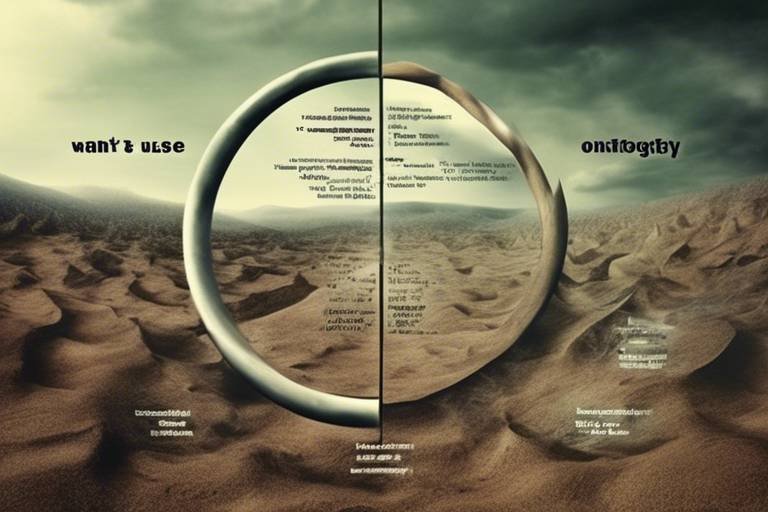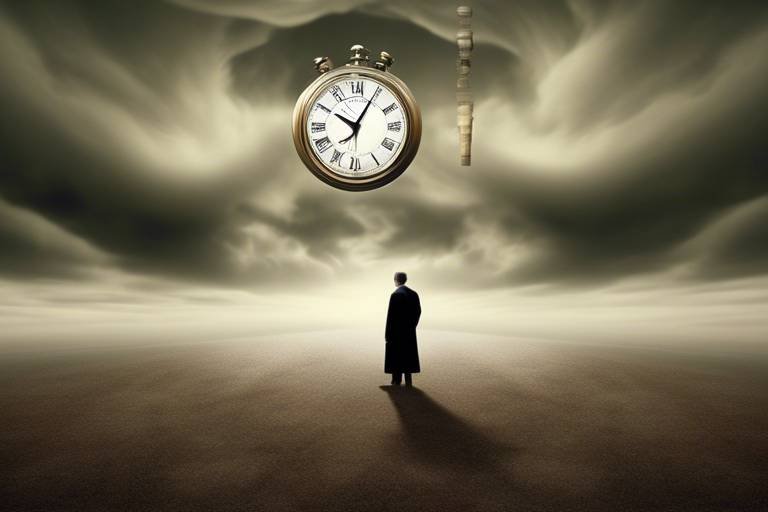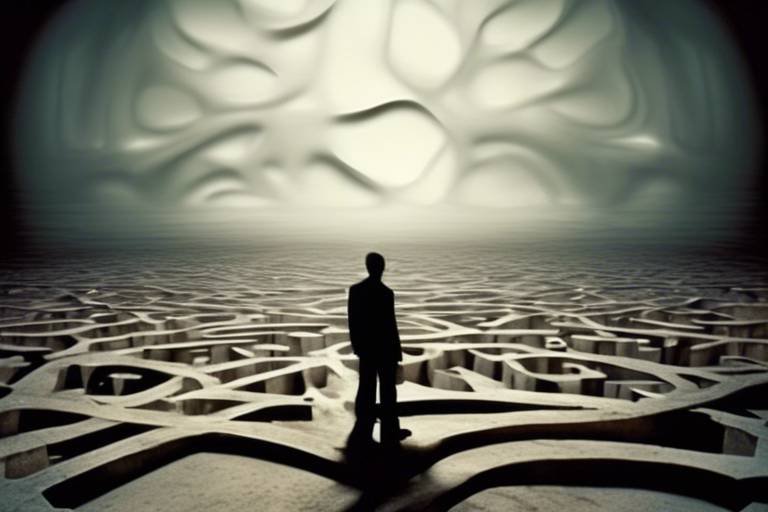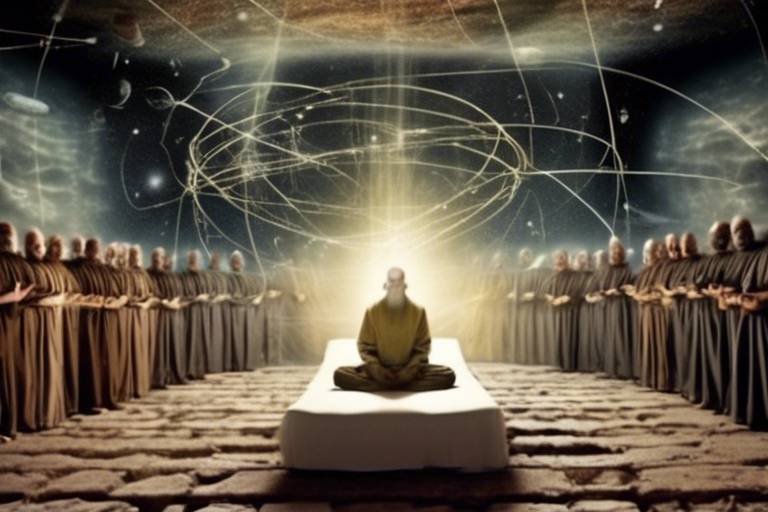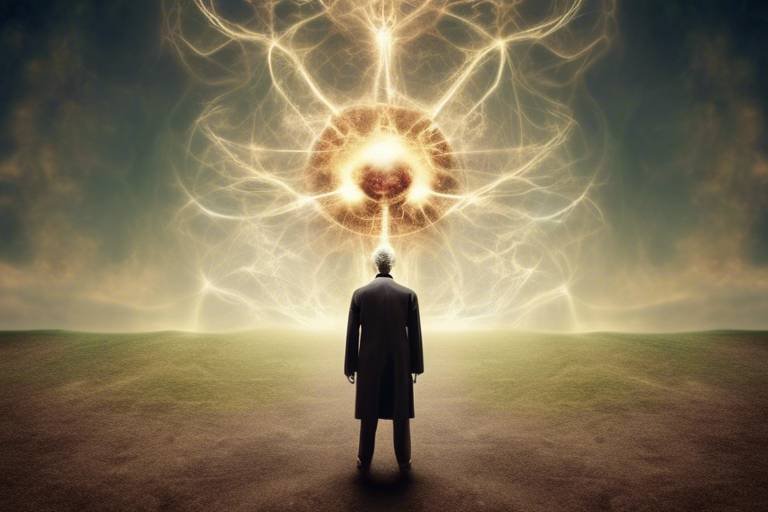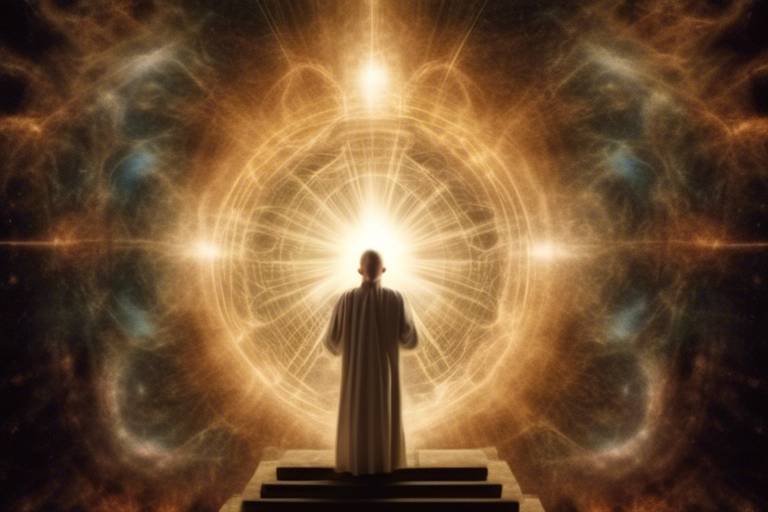Metaphysical Perspectives on Life, Death, and the Afterlife
Have you ever pondered the big questions of existence? What does it mean to be alive, and what happens when we die? These profound inquiries have intrigued humanity for centuries, and they sit at the heart of metaphysical exploration. Metaphysics, in its essence, seeks to unravel the mysteries that lie beyond the physical realm, inviting us to delve into the nature of reality, the self, and the universe. In this article, we will embark on a journey through various metaphysical perspectives, exploring how different philosophies interpret life, death, and the possibility of an afterlife. From ancient traditions to modern theories, we will uncover the rich tapestry of beliefs that shape our understanding of existence.
At its core, metaphysics challenges us to look beyond the surface of our daily lives. It asks us to consider not just what we experience, but why we experience it. Is life merely a series of random occurrences, or is there a deeper, interconnected purpose? As we navigate through contrasting views, we will see how these philosophical frameworks influence our perceptions of life’s journey and the inevitable end that awaits us all.
One of the most fascinating aspects of metaphysics is how it intertwines with cultural beliefs and spiritual practices. Different societies have developed unique interpretations of life and death, often reflecting their values, fears, and hopes. Whether through the lens of Eastern philosophies that embrace the cyclical nature of existence or Western traditions that emphasize linear progression, these perspectives provide us with a rich understanding of how humans grapple with the unknown.
As we explore these diverse views, we will also consider the implications of our beliefs. How do they affect our behavior, our relationships, and our moral frameworks? The answers may surprise you, revealing a complex interplay between thought, action, and the metaphysical forces that many believe govern our lives.
In the following sections, we will delve deeper into the nature of existence, the contrasting concepts of life and death, and the various beliefs surrounding the afterlife. Through this exploration, we aim to illuminate the profound questions that have persisted through time, inviting you to reflect on your own beliefs and experiences. So, buckle up as we embark on this enlightening journey into the metaphysical realms of life, death, and what lies beyond!
Examining what it means to exist, this section discusses different philosophical theories that define existence, including materialism, idealism, and existentialism, and how these perspectives influence our understanding of life and death.
This section explores the metaphysical interpretations of life and death, highlighting contrasting views on whether life is a linear journey or a cyclical process and how death is perceived in various cultures.
Focusing on Eastern metaphysical traditions, this part discusses concepts like reincarnation, karma, and the cycle of samsara, illustrating how these beliefs shape the understanding of life and death in cultures such as Hinduism and Buddhism.
This subsection delves into the principles of reincarnation and karma, explaining how actions in one life affect future existences and the moral implications of these beliefs on individual behavior and societal norms.
Here, we examine the belief in the cyclical nature of existence prevalent in Eastern philosophies, emphasizing how this perspective contrasts with Western linear views and its implications for understanding life and death.
This section highlights Western metaphysical perspectives on life and death, focusing on dualism, the soul's immortality, and the significance of existentialism in shaping beliefs about the afterlife and human purpose.
Exploring various theories about the afterlife, this section discusses beliefs from different cultures, including heaven, hell, and spiritual realms, as well as contemporary views on consciousness and existence beyond physical death.
This subsection investigates reports of spiritual experiences and near-death experiences (NDEs), analyzing their implications for understanding consciousness and the possibility of an afterlife from both scientific and anecdotal perspectives.
This part examines how various religions interpret the afterlife, discussing concepts of paradise, judgment, and reincarnation, and how these beliefs influence moral behavior and societal norms across different cultures.
- What is metaphysics? Metaphysics is a branch of philosophy that explores the fundamental nature of reality, existence, and the universe.
- Do all cultures believe in an afterlife? No, beliefs about the afterlife vary significantly across cultures, with some believing in reincarnation, others in heaven and hell, and some in no afterlife at all.
- How do metaphysical beliefs affect daily life? These beliefs can influence moral decisions, personal relationships, and how individuals cope with death and loss.
- What is the significance of karma in Eastern philosophies? Karma emphasizes that actions have consequences, affecting future lives and encouraging ethical behavior.

The Nature of Existence
When we dive into the profound question of what it means to exist, we find ourselves navigating a complex tapestry woven from various philosophical threads. Existence is not merely about being alive; it encompasses the very essence of our reality, our consciousness, and our interactions with the universe. Different philosophical theories attempt to define existence, and each offers a unique lens through which we can understand life and death.
One of the most prominent theories is materialism, which posits that everything that exists is physical and can be measured or observed. According to materialists, our thoughts, emotions, and even consciousness are products of physical processes in the brain. This perspective leads to a rather linear understanding of life, where existence begins at birth and ends at death, often leaving little room for what lies beyond. On the flip side, we have idealism, which suggests that reality is fundamentally mental or spiritual. Idealists argue that the physical world is an extension of our consciousness, implying that existence transcends the material realm. This view opens the door to the possibility of an afterlife, where our consciousness continues beyond the physical body.
Then there's existentialism, a philosophy that emphasizes individual existence, freedom, and choice. Existentialists believe that life has no inherent meaning, and it is up to each individual to create their own purpose. This perspective can be liberating yet daunting, as it places the responsibility of meaning-making squarely on our shoulders. The existential view can profoundly affect how we perceive death; if life is what we make of it, then death can be seen not as an end but as a transition to something unknown, a blank canvas awaiting our interpretation.
These philosophical perspectives do not exist in isolation; they often intertwine and influence each other, shaping our collective understanding of existence, life, and death. For instance, a materialist might grapple with existential questions, while an idealist could find solace in the existential belief in personal agency. This interplay leads to a rich dialogue about our place in the universe and the nature of reality itself.
Moreover, cultural context plays a significant role in shaping our metaphysical views. In many cultures, existence is viewed in relation to a larger cosmic order, where life and death are seen as interconnected phases of a greater cycle. This brings us to the idea of interdependence, where our existence is not just about individual life but also about our connections to others and the world around us. Understanding existence in this way can foster a sense of belonging and responsibility, prompting us to consider how our actions impact not only our lives but the lives of others.
In conclusion, the nature of existence is a multifaceted concept that invites us to explore the depths of our reality. By examining different philosophical theories—materialism, idealism, and existentialism—we can gain insights into our understanding of life and death. Each perspective offers a unique contribution to this ongoing conversation, encouraging us to ponder our existence and the possibilities that lie beyond.
- What is the meaning of existence? - The meaning of existence varies across philosophical perspectives, with some viewing it as a personal journey to create one's purpose, while others see it as a part of a larger cosmic order.
- How do different cultures perceive life and death? - Cultural beliefs significantly shape our understanding of life and death, influencing perspectives on mortality, the afterlife, and the interconnectedness of existence.
- Can existence be defined scientifically? - While materialism offers a scientific approach to understanding existence, other philosophies like idealism challenge purely scientific definitions by emphasizing the role of consciousness and perception.

When we dive into the metaphysical interpretations of life and death, we find ourselves navigating through a rich tapestry of beliefs and philosophies that vary dramatically across cultures and eras. At the heart of these concepts lies a fundamental question: Is life a linear journey with a definitive end, or is it a cyclical process that transcends the physical realm? The answers we seek often reflect our deepest fears, hopes, and existential curiosities. Some cultures view life as a precious gift, a fleeting moment in the grand scheme of existence, while others perceive it as merely a phase in an eternal cycle.
In many traditions, death is not seen as the end but rather as a transition into another state of being. For instance, in Eastern philosophies, death is often viewed as a doorway to rebirth, linking the past with the future through the concept of reincarnation. This cyclical nature of existence suggests that our actions in one life have profound implications for our future lives, creating a moral framework that encourages individuals to live virtuously. In contrast, Western philosophies tend to adopt a more linear perspective, emphasizing the finality of death and the importance of the soul's journey to an afterlife.
To illustrate these contrasting views, consider the following table that summarizes key differences between Eastern and Western interpretations of life and death:
| Aspect | Eastern Philosophies | Western Philosophies |
|---|---|---|
| View of Life | Cyclical; a series of rebirths | Linear; a single journey |
| View of Death | Transition to another life | Final end of existence |
| Moral Implications | Karma influences future lives | Judgment based on earthly life |
As we explore these perspectives, it's essential to recognize that they shape not only individual beliefs but also societal norms and behaviors. In cultures where life is viewed as cyclical, there is often a deep reverence for nature and a sense of interconnectedness among all living beings. Conversely, in societies that emphasize a linear journey, there tends to be a stronger focus on personal achievement and legacy.
Ultimately, the metaphysical concepts of life and death compel us to confront our own beliefs and the narratives we construct around our existence. They challenge us to ponder profound questions: What does it mean to live a meaningful life? How do we cope with the inevitability of death? And what, if anything, lies beyond? These inquiries are not just philosophical musings; they are deeply personal reflections that resonate with our experiences and shape our understanding of the world.
- What is the difference between Eastern and Western views on life and death? Eastern views often see life as cyclical and death as a transition, while Western views typically see life as linear with death as a final end.
- How does reincarnation influence behavior in Eastern cultures? The belief in reincarnation and karma encourages individuals to act morally, as their actions in this life will impact their future lives.
- What are the implications of viewing life as a linear journey? This perspective often leads to a focus on legacy and achievement, emphasizing the importance of making the most out of one's singular life.

When we dive into the rich tapestry of Eastern philosophies, we find a profound exploration of life's mysteries, particularly surrounding the concepts of reincarnation, karma, and the cycle of samsara. These beliefs are not just abstract ideas; they profoundly shape the way individuals and cultures perceive existence, death, and what may lie beyond. In traditions such as Hinduism and Buddhism, life is viewed not merely as a singular journey but as an intricate web of experiences that transcend individual lifetimes. Imagine life as a vast river, where every action creates ripples that influence the flow of the current, affecting not just the individual but the entire ecosystem of existence.
In Hinduism, the concept of reincarnation teaches that the soul is eternal, undergoing countless cycles of birth, death, and rebirth. This cycle, known as samsara, is driven by the law of karma, which posits that every action has consequences that ripple into future lives. If you do good, you may be reborn into favorable circumstances; if you do harm, your next life may be more challenging. This principle encourages moral behavior, emphasizing that our choices today shape our realities tomorrow. Think of it as a cosmic accounting system where every thought, word, and deed is meticulously recorded.
Buddhism, on the other hand, offers a slightly different perspective. While it also embraces the idea of rebirth, it places a significant focus on the cessation of suffering through the understanding of impermanence and the realization of nirvana. The cycle of samsara is seen as a source of suffering, and the ultimate goal is to break free from this cycle, achieving enlightenment. This concept can be likened to a butterfly emerging from a chrysalis; it symbolizes transformation and the quest for liberation from the constraints of physical existence.
Both philosophies emphasize the cyclical nature of existence, contrasting sharply with Western views that often perceive life as a linear path leading to a definitive end. In Eastern thought, life is not just about the destination—it's about the journey itself, the lessons learned, and the connections made along the way. This perspective fosters a sense of continuity and interconnectedness, reminding us that we are part of a larger whole. It's like viewing life as a grand tapestry, where each thread is vital to the overall design, and every experience contributes to the masterpiece of existence.
Ultimately, Eastern philosophies invite us to reflect on our place in the universe and challenge us to consider how our actions reverberate through time and space. They encourage a profound awareness of our interconnectedness, urging us to live with intention and compassion. As we navigate our own lives, we can draw inspiration from these teachings, recognizing that our journey is not just ours alone but part of a much larger cosmic story.
- What is the significance of karma in Eastern philosophies?
Karma is the principle of cause and effect, where every action has consequences that shape future experiences. It emphasizes moral responsibility and encourages individuals to act with compassion.
- How do Eastern philosophies view the concept of the afterlife?
Eastern philosophies often view the afterlife as a continuation of the cycle of rebirth, where the soul experiences different lives based on past actions and spiritual growth.
- What is the goal of Buddhist teachings regarding life and death?
The ultimate goal in Buddhism is to achieve enlightenment and break free from the cycle of samsara, thereby ending suffering and attaining nirvana.

Reincarnation and karma are two fundamental concepts deeply embedded in Eastern philosophies, particularly within Hinduism and Buddhism. These ideas offer a fascinating lens through which we can examine the cycle of life, death, and rebirth. At its core, reincarnation posits that the soul is immortal and undergoes a series of births and deaths, transitioning from one physical form to another. This cycle, known as samsara, is influenced by the actions (or karma) accumulated in previous lives. It's almost as if life is a grand tapestry, where each thread represents our choices, weaving together the fabric of our existence across multiple lifetimes.
Karma, derived from the Sanskrit word meaning "action," is the principle that every action has consequences. In this framework, good deeds lead to positive outcomes in future incarnations, while negative actions can result in suffering or hardship. Imagine karma as a cosmic bank account where every thought, word, and deed is deposited or withdrawn. This belief system encourages individuals to live ethically and mindfully, as their current actions directly affect their future circumstances. For instance, if someone is compassionate and generous in this life, they may find themselves in a favorable situation in their next life, perhaps born into a supportive family or enjoying good health.
Moreover, the interplay between reincarnation and karma raises profound questions about justice and morality. Some might wonder, "Why do bad things happen to good people?" In the context of reincarnation, the answer often lies in the idea that our current life is influenced by past actions, both from this life and previous ones. This perspective can provide a sense of comfort, suggesting that life’s injustices are not random but rather part of a larger, intricate cosmic plan. It emphasizes the importance of personal growth and learning through experiences, no matter how challenging they may be.
To better understand these concepts, let's take a closer look at how they manifest in different cultures:
| Culture | Beliefs about Reincarnation | Understanding of Karma |
|---|---|---|
| Hinduism | Rebirth in various forms based on karma | Actions in past lives determine current circumstances |
| Buddhism | Cycle of birth, death, and rebirth until enlightenment | Intentions behind actions shape future experiences |
| Jainism | Rebirth influenced by adherence to non-violence and truth | Karma is a physical substance that binds to the soul |
In conclusion, the concepts of reincarnation and karma offer profound insights into the nature of existence and the moral fabric that binds us all. They encourage a mindful approach to living, reminding us that our actions have far-reaching effects beyond our immediate experience. By embracing these philosophies, individuals can cultivate a deeper understanding of their lives and the interconnectedness of all beings.
- What is reincarnation? Reincarnation is the belief that the soul is reborn into a new body after death, continuing a cycle of life, death, and rebirth.
- How does karma work? Karma refers to the law of cause and effect, where every action has consequences that influence future experiences.
- Are reincarnation and karma only found in Eastern philosophies? While they are primarily associated with Eastern religions, similar concepts of moral consequence and rebirth can be found in various cultures and philosophies worldwide.
- Can karma be changed? Yes, individuals can change their karma through their actions and intentions in this life, potentially altering their future experiences.

The cyclical nature of existence is a profound concept that permeates various Eastern philosophies, suggesting that life is not a one-way street but rather an intricate loop of experiences, growth, and rebirth. Imagine life as a grand carousel, where each turn represents a different phase of existence. Just as the carousel spins, we find ourselves returning to familiar themes and lessons, each time with the opportunity to gain deeper insights. This perspective stands in stark contrast to the linear views often held in Western thought, where life is seen as a straight path leading to a definitive end.
In many Eastern traditions, particularly in Hinduism and Buddhism, the belief in the cycle of samsara—the continuous cycle of birth, life, death, and rebirth—plays a central role. This cycle is governed by the law of karma, which posits that our actions in one life directly influence our circumstances in the next. For instance, if one lives a life of compassion and kindness, they may be reborn into favorable conditions, whereas a life filled with harm may lead to more challenging circumstances in the next round of existence. This belief system invites individuals to consider the long-term consequences of their actions, fostering a sense of responsibility and ethical living.
Moreover, the cyclical nature of existence encourages a deeper understanding of suffering and joy. In this view, both are seen as temporary states, constantly ebbing and flowing like the tides. Rather than viewing death as an end, it is perceived as a transition—a necessary part of the cycle that brings about new beginnings. This perspective can be incredibly liberating, as it allows individuals to embrace change and uncertainty with a sense of peace, knowing that life is a series of interconnected experiences rather than a final destination.
To illustrate this concept further, consider the following table that summarizes key aspects of the cyclical nature of existence as understood in Eastern philosophies:
| Aspect | Description |
|---|---|
| Life | Seen as a journey of experiences, lessons, and growth. |
| Death | A transition point leading to rebirth, not an end. |
| Karma | The moral law of cause and effect influencing future existences. |
| Samsara | The continuous cycle of birth, life, death, and rebirth. |
This cyclical perspective not only shapes individual lives but also influences cultural practices and societal norms. Festivals celebrating rebirth and renewal, such as Diwali in Hinduism, embody the spirit of this philosophy, reminding us of the light that follows darkness and the opportunity for new beginnings. In contrast, Western cultures often emphasize the finality of death, which can lead to fear and anxiety surrounding the inevitable end of life. By embracing the cyclical nature of existence, individuals can cultivate a more profound appreciation for life’s transient beauty and the interconnectedness of all beings.
- What is the cyclical nature of existence? It refers to the belief that life is a continuous loop of experiences, where death leads to rebirth, influenced by karma.
- How does karma affect our lives? Karma posits that our actions in one life impact our circumstances in future existences, encouraging ethical behavior.
- What are the implications of this belief? It fosters a sense of responsibility, understanding that our actions have long-term consequences.
- How do Eastern philosophies view death? Death is seen as a transition rather than an end, allowing for renewal and new beginnings.
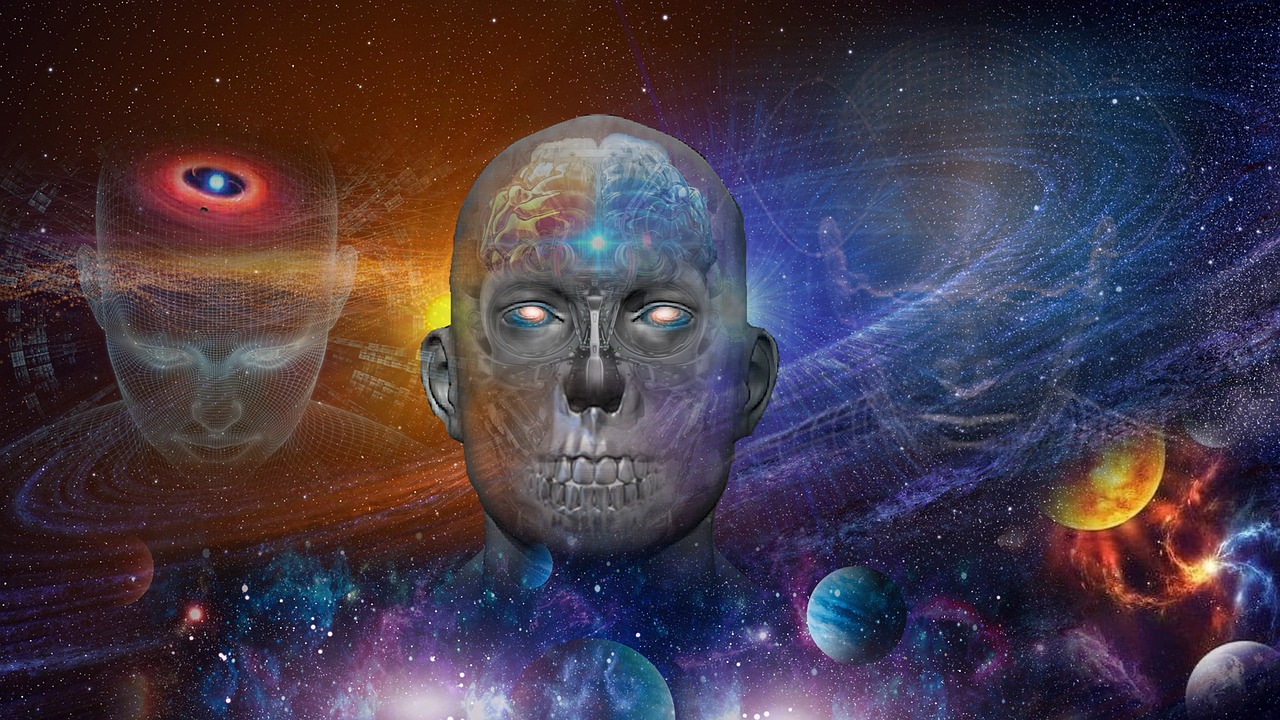
When we dive into the realm of Western philosophies, we find ourselves navigating a rich tapestry of ideas that have shaped our understanding of life, death, and what lies beyond. At the heart of these perspectives is a fascinating interplay between dualism, the belief in the immortality of the soul, and the profound inquiries posed by existentialism. These philosophies challenge us to ponder not just our existence, but also the nature of our essence and what might happen after we take our final breath.
One of the most influential ideas in Western thought is dualism, famously championed by philosophers like René Descartes. This view posits that there are two distinct realms: the physical and the non-physical. In simpler terms, it suggests that our bodies are separate from our minds or souls. This separation raises intriguing questions about the afterlife. If our souls exist independently of our bodies, what happens to them when we die? Many dualists assert that the soul continues to exist, embarking on a journey beyond this earthly realm.
In contrast, existentialism offers a more nuanced perspective. Thinkers like Jean-Paul Sartre and Albert Camus emphasized the importance of individual experience and choice in crafting our own meaning in life. They argue that life is inherently absurd, devoid of any predetermined purpose. This leads to a stark confrontation with the idea of death. Instead of viewing death as a transition to another existence, existentialists often see it as the ultimate end, which compels us to live authentically and embrace our freedom. This perspective can be both liberating and daunting—how do we find meaning in a world where our time is limited?
Interestingly, the Western view of the afterlife is often intertwined with religious beliefs, particularly those stemming from Christianity. The Christian doctrine presents a clear dichotomy of heaven and hell, where the soul's fate is determined by one's actions and faith during their lifetime. This belief in judgment after death profoundly influences moral behavior and societal norms. The promise of eternal bliss in heaven or the fear of punishment in hell serves as a powerful motivator for ethical living.
However, not all Western philosophies align neatly with religious ideologies. Some contemporary thinkers explore the idea of consciousness beyond physical death without necessarily adhering to traditional religious frameworks. They ponder questions like: Is consciousness a product of the brain, or does it exist independently? Can we truly understand what happens after death through scientific inquiry, or are we limited by our current understanding? These questions reflect a growing curiosity about the nature of existence and the possibility of an afterlife.
In summary, Western philosophies regarding life, death, and the afterlife present a complex interplay of ideas. From the dualistic separation of body and soul to the existentialist embrace of individual meaning-making, these perspectives invite us to explore profound questions about our existence. They compel us to reflect on our beliefs, our morals, and ultimately, what we hope to find beyond the veil of death.
- What is dualism in Western philosophy? Dualism is the belief that the mind and body are separate entities, leading to the idea that the soul can exist independently of the physical body.
- How does existentialism view death? Existentialism sees death as the ultimate end, prompting individuals to create their own meaning in life rather than relying on external sources.
- What role does religion play in Western views of the afterlife? Many Western philosophies are influenced by religious beliefs, particularly Christianity, which presents concepts of heaven and hell based on moral behavior and faith.
- Can consciousness exist after death according to contemporary thinkers? Some contemporary philosophers explore the idea that consciousness may exist independently of the brain, raising questions about the nature of existence beyond physical life.

The concept of the afterlife has fascinated humanity for centuries, igniting countless debates and discussions across cultures and religions. What happens when we take our last breath? Is there a continuation of consciousness, or do we simply fade into oblivion? These questions have led to a plethora of beliefs and theories, each providing a unique perspective shaped by cultural, spiritual, and philosophical influences. From the fiery depths of hell to the serene embrace of heaven, the afterlife is often depicted in vivid imagery that reflects our deepest hopes and fears about mortality.
Across various cultures, the afterlife is not merely an abstract concept but a vital part of their belief systems. For instance, in many Western religions, the afterlife is often seen as a final destination determined by one's actions during life. This dualistic view posits a clear division between good and evil, often illustrated through the concepts of heaven and hell. In contrast, Eastern philosophies suggest a more cyclical approach, where life and death are part of an ongoing process of rebirth and reincarnation. Such contrasting beliefs raise intriguing questions about morality, purpose, and the nature of existence itself.
To better understand these diverse beliefs, we can categorize them into several key themes:
- Heaven and Hell: Many Abrahamic religions, including Christianity and Islam, present a binary view of the afterlife where individuals are rewarded or punished based on their earthly deeds.
- Reincarnation: In Hinduism and Buddhism, the soul undergoes a cycle of birth, death, and rebirth, influenced by karma, which dictates the circumstances of each new life.
- Spiritual Realms: Various spiritual traditions propose the existence of different planes of existence or realms where souls reside after death, often characterized by their vibrational frequency.
Moreover, the exploration of near-death experiences (NDEs) has added a fascinating layer to our understanding of the afterlife. People who have experienced NDEs often report vivid encounters with light, feelings of peace, and sometimes even interactions with deceased loved ones. These accounts, while anecdotal, have sparked interest among scientists and spiritual seekers alike, challenging the boundaries of our understanding of consciousness and existence beyond physical death.
Religious interpretations of the afterlife further illustrate the diversity of beliefs. For example, in Christianity, the afterlife is often viewed as a time of judgment where the soul is assessed based on faith and deeds, leading to eternal life in heaven or damnation in hell. In contrast, Buddhism emphasizes the importance of achieving enlightenment to break free from the cycle of samsara, ultimately leading to Nirvana—a state of liberation and peace. This divergence highlights how cultural narratives shape our perceptions of life, death, and what may lie beyond.
In summary, the afterlife remains one of the most profound mysteries of human existence. Whether viewed through the lens of religion, philosophy, or personal experience, our beliefs about what happens after we die significantly influence how we live our lives. They shape our moral frameworks, cultural practices, and even our psychological well-being. As we continue to explore these metaphysical perspectives, we gain not only insight into the afterlife but also a deeper understanding of our own existence.
Here are some common questions regarding the afterlife:
- What is the afterlife? The afterlife refers to the existence or state of being that follows physical death, often characterized by various beliefs about what happens to the soul or consciousness.
- Do all religions believe in an afterlife? While many religions have concepts of an afterlife, the specifics vary greatly. Some believe in heaven and hell, while others embrace reincarnation or spiritual realms.
- What are near-death experiences? Near-death experiences are profound psychological events that may occur to individuals who have come close to death or experienced clinical death, often described as a journey to another realm.
- Can our beliefs about the afterlife impact our lives today? Yes, beliefs about the afterlife can influence moral behavior, life choices, and even mental health, as they provide frameworks for understanding existence and purpose.

When we dive into the realm of spiritual experiences and near-death experiences (NDEs), we're stepping into a fascinating territory that blurs the lines between life and what lies beyond. Many individuals who have had NDEs report profound transformations in their understanding of existence, often describing vivid encounters with light, feelings of unconditional love, and a sense of being enveloped in a greater reality. These experiences can leave a lasting impact, reshaping their beliefs about life, death, and the afterlife. What if these moments are not just hallucinations but glimpses into a reality that we have yet to fully comprehend?
Scientific studies have attempted to dissect these experiences, seeking to understand their neurobiological underpinnings. For instance, during traumatic events, the brain may release a cocktail of chemicals, including endorphins and dopamine, which can produce euphoric sensations. However, many argue that this explanation falls short of capturing the profound nature of the experiences reported. People often describe a heightened state of awareness, where they feel as if they are observing their own bodies from a distance, leading to questions about the nature of consciousness itself. Are we merely our brains, or is there something more?
To better understand the implications of NDEs, let's look at some common themes that emerge from these experiences:
- Life Review: Many individuals recount undergoing a review of their life, where they relive their actions and their impacts on others. This process often leads to a deeper understanding of their moral choices.
- Encounters with Beings of Light: A significant number of NDErs report meeting spiritual beings or deceased loved ones, which can provide comfort and a sense of connection to a larger reality.
- Feeling of Peace: A common sentiment is an overwhelming feeling of peace and acceptance, contrasting sharply with the fear typically associated with death.
These themes suggest that NDEs may serve as a transformative experience, prompting individuals to reevaluate their lives and priorities. Many return with a renewed sense of purpose, often becoming advocates for love, compassion, and spiritual growth. This phenomenon raises intriguing questions: Could these experiences be a bridge between the physical and spiritual realms? What do they tell us about the nature of consciousness and existence?
In addition to anecdotal evidence, some researchers have conducted studies to analyze the psychological and emotional effects of NDEs. A study published in the journal Resuscitation found that individuals who experienced NDEs reported significantly lower levels of anxiety about death compared to those who had not. This suggests that these experiences may play a crucial role in shaping how we perceive mortality and the afterlife.
As we navigate through these profound experiences, it becomes evident that they challenge our traditional notions of life and death. They invite us to ponder the possibility that consciousness might exist beyond the physical body, sparking a wider conversation about the nature of reality itself. Are we merely biological entities, or do we possess an essence that transcends our physical existence?
In conclusion, the exploration of spiritual experiences and near-death experiences opens up a treasure trove of questions about our existence, purpose, and what lies beyond the veil of death. As we continue to study these phenomena, we may uncover deeper truths about the human experience, potentially reshaping our understanding of life, death, and everything in between.
- What are near-death experiences? Near-death experiences are profound psychological events that may occur to individuals who are close to death or in situations of intense physical or emotional distress.
- Do NDEs provide evidence of an afterlife? While many interpret NDEs as evidence of an afterlife, the scientific community remains divided, with some attributing them to physiological responses in the brain.
- How do NDEs affect individuals after the experience? Many individuals report lasting changes in their outlook on life, often feeling more connected to others and less fearful of death.

The concept of the afterlife has been a profound aspect of human culture, deeply embedded within various religious beliefs. Each religion offers its own unique interpretation of what happens after we take our final breath, reflecting the values and philosophies of its followers. For many, the afterlife serves as a guiding principle for moral behavior during their earthly existence. The beliefs surrounding the afterlife can often be categorized into several key themes, including the ideas of paradise, judgment, and reincarnation.
In Christianity, the afterlife is predominantly viewed through the lens of heaven and hell. Heaven is often described as a place of eternal peace and communion with God, while hell is depicted as a realm of punishment for those who have sinned. This dichotomy encourages believers to live a life aligned with the teachings of Jesus Christ, emphasizing love, compassion, and forgiveness. The notion of judgment plays a critical role in this belief system, where individuals are held accountable for their actions on Earth. As the Bible states, "For we must all appear before the judgment seat of Christ" (2 Corinthians 5:10), highlighting the importance of moral conduct.
In contrast, Buddhism presents a different perspective on the afterlife, focusing on the cycle of rebirth known as samsara. According to Buddhist teachings, the actions and intentions of an individual (karma) directly influence their future existences. This cyclical view encourages individuals to seek enlightenment and liberation from the cycle of rebirth, ultimately striving for Nirvana—a state of ultimate peace and freedom from suffering. The teachings of Buddha emphasize the impermanence of life, suggesting that attachment to earthly desires can lead to suffering in future lives. Thus, ethical living and mindfulness become essential practices for those following this path.
Hinduism also embraces the concept of reincarnation, where the soul is believed to be eternal and undergoes a series of births and deaths. The actions performed in one life (karma) determine the circumstances of future lives, creating a moral framework that encourages righteous living. The ultimate goal in Hindu belief is to achieve moksha, or liberation from the cycle of rebirth, allowing the soul to unite with the divine. This belief fosters a sense of responsibility, as individuals understand that their actions have far-reaching consequences beyond their current existence.
Islam provides another intriguing interpretation of the afterlife. Muslims believe in a Day of Judgment when all individuals will be resurrected and held accountable for their deeds. Based on their actions, they will be directed to either Jannah (paradise) or Jahannam (hell). The Quran emphasizes the mercy of Allah, suggesting that sincere repentance can lead to forgiveness, thus offering hope to believers. This belief encourages followers to live a life of submission to God's will, fostering a strong sense of community and moral responsibility.
Across these diverse religious interpretations, one common thread emerges: the afterlife serves as a powerful motivator for ethical behavior and personal growth. Whether through the promise of eternal bliss, the fear of punishment, or the pursuit of enlightenment, these beliefs shape the lives of millions. Understanding these varying perspectives not only enriches our knowledge of human culture but also invites us to reflect on our own beliefs about existence and what may lie beyond.
- What is the significance of the afterlife in different religions? The afterlife serves as a moral compass, guiding individuals in their actions and decisions during their earthly lives.
- How do beliefs about the afterlife influence behavior? Many religions use the concept of the afterlife to encourage ethical living, with consequences tied to one's actions in this life.
- What are the main differences between Eastern and Western views on the afterlife? Eastern philosophies often emphasize reincarnation and a cyclical existence, while Western religions typically focus on a linear journey with a final judgment.
Frequently Asked Questions
- What is metaphysics and how does it relate to life and death?
Metaphysics is a branch of philosophy that explores the fundamental nature of reality, including concepts like existence, objects, and their properties. When it comes to life and death, metaphysical perspectives help us understand the deeper meanings behind existence and what might happen after we die. These views can vary widely, influencing our beliefs about the nature of life itself.
- How do Eastern philosophies view life and death?
Eastern philosophies, such as Hinduism and Buddhism, often see life and death as part of a cyclical process. They believe in concepts like reincarnation and karma, which suggest that our actions in this life affect our future existences. This perspective emphasizes the interconnectedness of life and the ongoing journey of the soul through various lives.
- What are some key beliefs about the afterlife in Western philosophies?
Western philosophies typically focus on ideas of dualism and the immortality of the soul. Many believe in an afterlife where the soul continues to exist in a different realm, often categorized as heaven or hell. Existentialism also plays a role, as it encourages individuals to find personal meaning in their lives, even in the face of death.
- What are near-death experiences (NDEs) and what do they tell us?
Near-death experiences are reported occurrences when individuals come close to death and often describe vivid, transformative experiences. These experiences can include feelings of peace, seeing a bright light, or encountering deceased loved ones. While scientific explanations exist, many interpret NDEs as evidence of consciousness surviving beyond physical death, adding another layer to our understanding of the afterlife.
- How do different religions interpret the afterlife?
Religious interpretations of the afterlife vary significantly. For instance, Christianity often speaks of judgment and the dichotomy of heaven and hell, while Hinduism embraces the cycle of reincarnation based on karma. These beliefs shape moral behavior and societal norms, guiding followers on how to live their lives in accordance with their faith.


